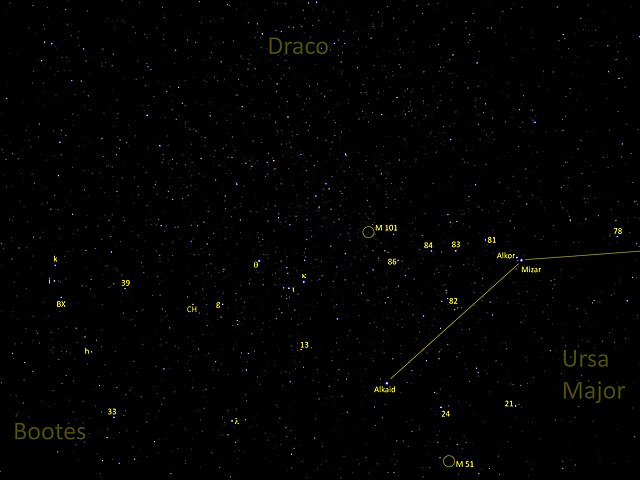Loading AI tools
Galaxy in the constellation Ursa Major From Wikipedia, the free encyclopedia
The Pinwheel Galaxy (also known as Messier 101, M101 or NGC 5457) is a face-on, unbarred, and counterclockwise spiral galaxy located 21 million light-years (6.4 megaparsecs)[5] from Earth in the constellation Ursa Major. It was discovered by Pierre Méchain in 1781[lower-alpha 1] and was communicated that year to Charles Messier, who verified its position for inclusion in the Messier Catalogue as one of its final entries.
| Pinwheel Galaxy | |
|---|---|
 The Pinwheel Galaxy, as taken by Hubble Space Telescope | |
| Observation data (J2000 epoch) | |
| Constellation | Ursa Major |
| Right ascension | 14h 03m 12.6s |
| Declination | +54° 20′ 57″ |
| Redshift | 0.000804 |
| Heliocentric radial velocity | 241 ± 2 km/s |
| Distance | 20.9 ± 1.8 Mly (6.4 ± 0.5 Mpc) |
| Apparent magnitude (V) | 7.9[1] |
| Characteristics | |
| Type | SAB(rs)cd |
| Number of stars | 1 trillion (1012) |
| Size | 51.91 kpc (169,300 ly) (diameter; 25.0 mag/arcsec2 B-band isophote)[2][3] |
| Apparent size (V) | 28′.8 × 26′.9 |
| Other designations | |
| Messier 101, M101, NGC 5457, UGC 8981, PGC 50063, Arp 26 | |

On February 28, 2006, NASA and the European Space Agency released a very detailed image of the Pinwheel Galaxy, which was the largest and most detailed image of a galaxy by Hubble Space Telescope at the time.[10] The image was composed of 51 individual exposures, plus some extra ground-based photos.
Pierre Méchain, the discoverer of the galaxy, described it as a "nebula without star, very obscure and pretty large, 6' to 7' in diameter, between the left hand of Bootes and the tail of the great Bear. It is difficult to distinguish when one lits the [grating] wires."[11]
William Herschel wrote in 1784 that the galaxy was one of several which "...in my 7-, 10-, and 20-feet [focal length] reflectors shewed a mottled kind of nebulosity, which I shall call resolvable; so that I expect my present telescope will, perhaps, render the stars visible of which I suppose them to be composed."[11]
Lord Rosse observed the galaxy in his 72-inch-diameter Newtonian reflector during the second half of the 19th century. He was the first to make extensive note of the spiral structure and made several sketches.[11]
Though the galaxy can be detected with binoculars or a small telescope, to observe the spiral structure in a telescope without a camera requires a fairly large instrument, very dark skies, and a low-power eyepiece.[12]

M101 is a large galaxy, with a diameter of 170,000 light-years. By comparison, the Milky Way has a diameter of 87,400 light-years.[13] It has around a trillion stars.[14] It has a disk mass on the order of 100 billion solar masses, along with a small central bulge of about 3 billion solar masses.[15] Its characteristics can be compared to those of Andromeda Galaxy.
M101 has a high population of H II regions, many of which are very large and bright. H II regions usually accompany the enormous clouds of high density molecular hydrogen gas contracting under their own gravitational force where stars form. H II regions are ionized by large numbers of extremely bright and hot young stars; those in M101 are capable of creating hot superbubbles.[16] In a 1990 study, 1,264 H II regions were cataloged in the galaxy.[17] Three are prominent enough to receive New General Catalogue numbers—NGC 5461, NGC 5462, and NGC 5471.[18]
M101 is asymmetrical due to the tidal forces from interactions with its companion galaxies. These gravitational interactions compress interstellar hydrogen gas, which then triggers strong star formation activity in M101's spiral arms that can be detected in ultraviolet images.[19]
In 2001, the X-ray source P98, located in M101, was identified as an ultra-luminous X-ray source—a source more powerful than any single star but less powerful than a whole galaxy—using the Chandra X-ray Observatory. It received the designation M101 ULX-1. In 2005, Hubble and XMM-Newton observations showed the presence of an optical counterpart, strongly indicating that M101 ULX-1 is an X-ray binary.[20] Further observations showed that the system deviated from expected models—the black hole is just 20 to 30 solar masses, and consumes material (including captured stellar wind) at a higher rate than theory suggests.[21]
It is estimated that M101 has about 150 globular clusters,[22] the same as the number of the Milky Way's globular clusters.
M101 has six prominent companion galaxies: NGC 5204, NGC 5474, NGC 5477, NGC 5585, UGC 8837 and UGC 9405.[23] As stated above, the gravitational interaction between it and its satellites may have spawned its grand design pattern. The galaxy has probably distorted the second-listed companion.[23] The list comprises most or all of the M101 Group.[24][25][26][27]
Six internal supernovae have been recorded:
Seamless Wikipedia browsing. On steroids.
Every time you click a link to Wikipedia, Wiktionary or Wikiquote in your browser's search results, it will show the modern Wikiwand interface.
Wikiwand extension is a five stars, simple, with minimum permission required to keep your browsing private, safe and transparent.